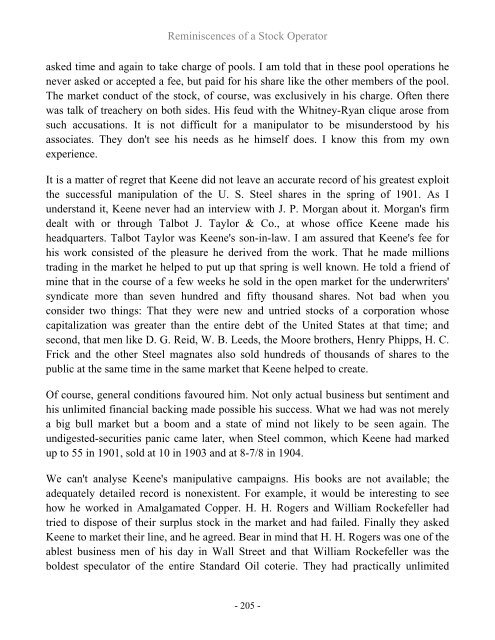Create successful ePaper yourself
Turn your PDF publications into a flip-book with our unique Google optimized e-Paper software.
Reminiscences of a Stock Operator<br />
asked time and again to take charge of pools. I am told that in these pool operations he<br />
never asked or accepted a fee, but paid for his share like the other members of the pool.<br />
The market conduct of the stock, of course, was exclusively in his charge. Often there<br />
was talk of treachery on both sides. His feud with the Whitney-Ryan clique arose from<br />
such accusations. It is not difficult for a manipulator to be misunderstood by his<br />
associates. They don't see his needs as he himself does. I know this from my own<br />
experience.<br />
It is a matter of regret that Keene did not leave an accurate record of his greatest exploit<br />
the successful manipulation of the U. S. Steel shares in the spring of 1901. As I<br />
understand it, Keene never had an interview with J. P. Morgan about it. Morgan's firm<br />
dealt with or through Talbot J. Taylor & Co., at whose office Keene made his<br />
headquarters. Talbot Taylor was Keene's son-in-law. I am assured that Keene's fee for<br />
his work consisted of the pleasure he derived from the work. That he made millions<br />
trading in the market he helped to put up that spring is well known. He told a friend of<br />
mine that in the course of a few weeks he sold in the open market for the underwriters'<br />
syndicate more than seven hundred and fifty thousand shares. Not bad when you<br />
consider two things: That they were new and untried stocks of a corporation whose<br />
capitalization was greater than the entire debt of the United States at that time; and<br />
second, that men like D. G. Reid, W. B. Leeds, the Moore brothers, Henry Phipps, H. C.<br />
Frick and the other Steel magnates also sold hundreds of thousands of shares to the<br />
public at the same time in the same market that Keene helped to create.<br />
Of course, general conditions favoured him. Not only actual business but sentiment and<br />
his unlimited financial backing made possible his success. What we had was not merely<br />
a big bull market but a boom and a state of mind not likely to be seen again. The<br />
undigested-securities panic came later, when Steel common, which Keene had marked<br />
up to 55 in 1901, sold at 10 in 1903 and at 8-7/8 in 1904.<br />
We can't analyse Keene's manipulative campaigns. His books are not available; the<br />
adequately detailed record is nonexistent. For example, it would be interesting to see<br />
how he worked in Amalgamated Copper. H. H. Rogers and William Rockefeller had<br />
tried to dispose of their surplus stock in the market and had failed. Finally they asked<br />
Keene to market their line, and he agreed. Bear in mind that H. H. Rogers was one of the<br />
ablest business men of his day in Wall Street and that William Rockefeller was the<br />
boldest speculator of the entire Standard Oil coterie. They had practically unlimited<br />
- 205 -


